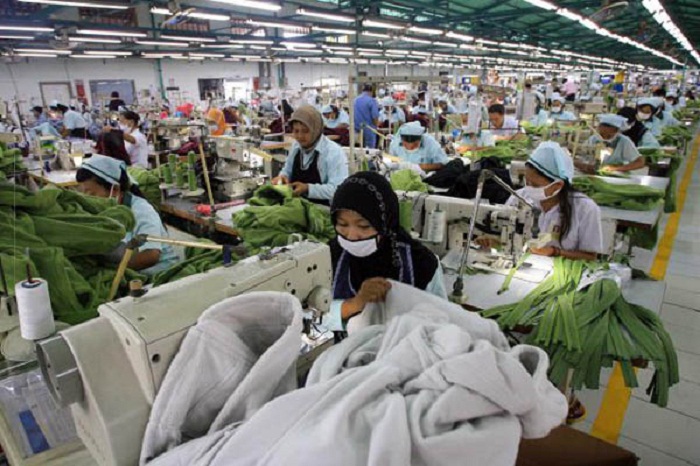
REPUBLIC OF INDONESIA POTENTIALLY MASTER 45 WORLD MARKETS
Secretary General of Indonesian Filament and Fiber Films Association (APSyFI) Redma Wirawasta said current instant policy with the freedom of importing textile raw materials does not encourage exports.
"Instant policy of the Ministry of Trade that encourages exports with imported raw materials is very wrong. Evidently our exports do not grow despite the freedom of imported raw materials, "said Redma, Wednesday (7/3)
Currently the competitiveness of Indonesian textile manufacturers is less than the maximum because of the high cost of energy, labor to logistics. To compete with other countries, this chronic problem needs to be addressed. "Including the completion of multiple tax regulations," he said.
By improving the competitiveness component, Indonesia's exports are expected to grow an average of 12% per year. If this performance can be maintained, Indonesia can increase global export market share by 4% in the next 5 years.
On a separate occasion, Secretary General of the Indonesian Textile Association (API) Ernovian G. Ismi said the synergies maintained from upstream to downstream industries and the decline in raw material imports could re-establish the position of Indonesia's textile industry in the world market.
"Opportunities still exist because Indonesia's production capacity is still low. New 80%, "he said.
Ernovian rate judge along with the increasing world demand, the market share of Indonesia textile actually recorded anomaly. Market share of 1.8% in 2016 actually shrank to 1.6%.
World demand is down but demand in Asia is increasing but even our share [Indonesia] is decreasing. Meanwhile, statistics recorded an increase in export volume, "Ernovian said, Wednesday (7/3).
Strengthening trade relations, especially with the four-seater countries that have high demand for textiles due to weather shifts also need to be improved.
UPDATES TECHNOLOGY
Meanwhile, Pan Brothers is continuing to update its technology and equipment to achieve its target as Southeast Asia's largest textile company by 2019.
"Even we are targeting in the next 7 years to be number one in Asia. Already prepared his path, "said Vice Chief Executive Officer Pan Brothers Anne Patricia Susanto in Jakarta, Wednesday.
To boost the company's sales will focus on optimizing existing factories. In addition, the new factory's presence in Tasikmalaya also strengthens the company's production capacity. Development will also be directed in this region.
[Southeast Asia's number one pursuit strategy] We can do organic, inorganic, or collaborative growth. So add sales with cooperation. Currently we have a [new factory] in Tasikmalaya, we see if it is possible to develop a second plant there, "said Anne.
The company accounts for 98% of total production in 23 factories for export market. Only 2% are released to the domestic market. Of this export segment, 56% came from the Asian market, 26% from the United States, while the rest for Europe.
 English
English Japan
Japan

show pictures of viagra working can women take mens viagra sildenafil manufacturers cheap online viagra new approval for generic viagra best generic viagra pharmacies
dapoxetine india price website priligy que edad lo pueden tomar where can you buy dapoxetine not online
neurontin mental health order neurontin neurontin is used to treat what is gabapentin 300mg capsules used for
plaquenil treatment plaquenil skin side effects is diflucan and plaquenil related why does plaquenil work for lupus
ventolin hfa expired where can i buy ventolin nebules online how much is a 90 day supply of ventolin in the uk?
recreational use of viagra what is viagra cialis for daily use dose chinese male enhancement effects of sildenafil on women homemade viagra trust pharmacy viagra list of all migraine medications natural viagra for men medication classification list vitamins for sexual benefits for men what insurance does walgreens accept women viagra cialis 5mg daily use reviews best herb for women's libido drug sildenafil citrate viagra price viagra super active vs viagra lantus solostar cialis 20mg tablets coupon goodrx viagra sunscreen samples for healthcare professionals cialis 2.5 mg daily nitroglycerin and viagra interaction cialis vs viagra male libido enhancement walmart prescription discount card granuflo lawsuit settlements prescription drugs canada buy online otc viagra brand name viagra 100mg
plaquenil sulfa allergy side effects plaquenil 200 mg what is a substitute for plaquenil
flovent vs ventolin ventolin prescription uk what is albuterol used for how much is albuterol sulfate without insurance
prednisone 5mg tablets prednisone brand will prednisone make you sleepy google what is prednisone used for
ivermectin for acne stromectol tab is ivermectin safe for cats how long does ivermectin stay in manure after dosing
oct plaquenil hydroxychloroquine generic price icd 10 plaquenil eye exam how does plaquenil lower glucose levels
does medicare pay for trulicity how to try viagra goodrx sam's club sildenafil goodrx is it a scam viagra 50 mg price cvs
taking amoxicillin buy amoxil 250mg uk amoxil clavulanate 875/125 dosage amoxil 500 for ear infection
amoxil medication australia amoxicillin in india amoxicillin warnings amoxicillin for pets
amoxil walmart buy amoxil 1000mg canada amoxil 500 for sore throat amoxicillin vs azithromycin
best natural libido booster for men viagra single pills for sale levitra vs viagra does generic viagra really work how quickly does contrave work ed pills that work better than viagra
prednisone for cough prednisone on line does prednisone make you lose weight a nurse is caring for a client who has nephrotic syndrome and has been taking prednisone for 3 days
price of ventolin albuterol 1.25 mg para que sirve el albuterol how long till ventolin works
printable drug classification chart walmart purchase history viagra pills for men how much is viagra safety of viagra